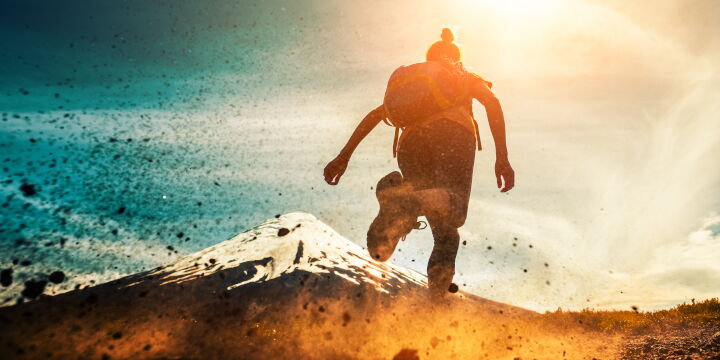Completely away from kilometer rhythms and tiring repetitions, super-technological watches that mark precise timing..
Emotion, nature and the heartbeat in the muffled silence of nature!
Far from the racing seasons, many runners allow themselves a break of physical and mental regeneration, which is indispensable, in my opinion, to face the next season on the right foot and full of energy.
This could be the opportunity to get closer to mountain running: a valid alternative for those who cannot give up running endorphins.
Each runners will let themselves be captured by the surrounding scenic beauty and wonderful views, so much so that they feel an irrepressible urge to stop training to take pictures with a unique background behind them.
But how to approach trail running as a beginner?

How many times have we been told "is the mountain dangerous?" Absolutely true!
But with awareness and criteria, a minimum of preparation and adequate equipment can give moments to live serenely and away from dangers: just be careful!!!
Trail running, instructions for use: 4 rules to keep in mind!
Don't think about running pace
Dont take continuous references of the pace per km as is customary in road racing: difference in height, altitude, uneven terrain and climatic conditions affect the pace of the race in a very important way.
Remove the "stress of the stopwatch" and the training schedule: free your mind, breathe deeply and immerse yourself at 360 degrees in nature, fully enjoying pure air, panoramas, sounds, scents and that priceless feeling of freedom.

regulated by the FIDAL (Italian Federation of Athletics) and in the world by the International Association of Athletics Federetions takes place in a mountain environment with short asphalted sections that must not exceed 20% of the total length, the maximum altitude must not exceed 3.ooo meters of altitude and the slope must be between 5 and 20%
2. Manage the climb as best you can
Dont face the climbs with excessive force and intensity so as not to find yourself, after a few steps, with exhausted muscles and forced to walk or stop to recover.
On some uphill stretches it may be useful to alternate a few running steps with a few walking steps with the help of trail running poles; in this way you will be faster and more constant in the effort, working less.
When you run uphill, I recommend that you prefer a high number of short and agile steps (high step frequency) and not long and "cumbersome" which require a very high muscular effort and penalize balance and stability on the ground.
On the uphill stretches continuous walking can be advantageous and effective, in particular, when the terrain is technically demanding (bumpy, rocky, muddy, slippery, etc.).
Walking on the most prohibitive slopes you will be able to maintain the same speed that you would be able to sustain by running with less effort and saving precious energy; you will also be able to better manage the effort by alternating the use of a different musculature from the specific one of the race, preserving the latter for the following less difficult stretches.
3. Don't underestimate the descent
We were taught that "the harder the climb, the more beautiful the descent will be"..
But sometimes the descent can be more challenging than the climb!
In particular, when tiredness and muscle fatigue begin to make themselves felt and concentration and clarity also begin to fail, the slope of a descent can require considerable muscular effort.

The descent requires a mastery of technique and the development of characteristics such as elasticity, reactivity, agility, balance, stability and strength to better control the stroke, reduce the impact force on the ground and the braking phase and maintain constant speed and fluidity in the movements .
On technical descents you prefer a very high frequency of steps: a rapid alternation of the supports limits the time of contact of the foot with the ground, reducing the impact force on the ground and consequently the impact on structures (muscles, tendons, ligaments, joints and bone). A high cadence also contributes to greater control and stability on uneven, unstable and slippery surfaces, reducing the risk of falls and trauma.
4. Take care of the recovery
Now that between climbs, descents, crests and single tracks, your race has come to an end, do not underestimate an optimal recovery!!!
Probably the context in which you have immersed yourself will have captured your attention so much that it has distracted you from the effort and the passage of time. It may happen that you have run much more than what was established at the start and with sustained intensity rhythms.

A mountain running training requires a great muscular effort and a high expenditure of energy; therefore, recovery starting from the first phase in the immediate post-workout is of fundamental importance.
First of all, it is important to recover the energy expended immediately and hydrate properly trying to do it within the first hour of the end of the workout.
Subsequently, a shower or a hot bath, alternating short phases with jets of cold water on the legs to promote circulation, can help the muscles to relax and recover more quickly.
Finally, let's not forget the rest that will always be an excellent ally for optimal recovery. Trail running is an excellent endurance and muscle strengthening training for the runner, also useful for developing, improving and consolidating technical and coordination skills. It undoubtedly requires a considerable muscular effort and, consequently, a gradual adaptation, the right recovery times and a correct balance in the training plan. But be sure that if managed correctly it will not compromise the return to the preparation of any road races but will, on the contrary, give a boost to your performance!
